Customer acquisition cost (CAC): What it is and how to calculate CAC

The importance of knowing your business’s customer acquisition cost
Keeping close tabs on your business’s profitability is pivotal to driving long-term success, and Customer Acquisition Cost (CAC) is a key factor. Customer Acquisition Cost, also known as user acquisition cost, consumer acquisition cost, or simply the cost to acquire a customer, gives you a clear picture of how much you spend to bring in each customer. This critical insight can help optimize your marketing, sales, and customer success strategies. When you lower your CAC, your profit margins inevitably increase!
So how do you calculate CAC, and what is the customer acquisition cost formula you should use? By the end of this blog, you'll have a comprehensive understanding of CAC and how to leverage it to drive your business forward. Let's dive in!
What is Customer Acquisition Cost (CAC)?
Customer Acquisition Cost (CAC) is a key metric that measures the total cost of acquiring a new customer. This metric includes all the expenses associated with attracting and converting a customer, including marketing costs, sales salaries, and other costs involved in the customer acquisition process. CAC provides insight into the efficiency and effectiveness of a company's customer acquisition strategies. The better you understand CAC, the easier it will be to gauge the effectiveness of your marketing and sales strategies and allocate resources more efficiently. CAC is also known as user acquisition cost, consumer acquisition cost, or simply the cost to acquire a customer.
CAC varies significantly across industries, with one report showing that financial services ($784), higher education ($1,143), and software development ($720) are among the B2B companies with the highest CAC. There are many different strategies for improving CAC, but one impactful approach in the B2B space has been moving to digital sales — which is shown to increase acquisition efficiency by up to 30%.
Customer acquisition cost formula
The formula to calculate customer acquisition cost is:
CAC = Total marketing and sales expenses to acquire a customer / Number of new customers acquired
Let’s break it down:
Total sales and marketing expenses: This includes all costs related to marketing campaigns, team salaries, software tools, advertising, overheads, and any other costs for acquiring new customers.
Number of total new customers acquired: The total number of customers gained during the period you’re measuring.
How to calculate CAC
Here are 2 examples of a CAC calculation.
CAC calculation example #1
Imagine you run a SaaS company and want to know how much it costs to acquire a new customer. Over 3 months, you spend $50,000 on marketing campaigns and $30,000 on sales efforts. During this time, you acquire 500 new customers. The CAC calculation:
CAC = (50,000+30,000)/500 = 80,000/500 = $160
This means it costs you $160 to acquire each new customer.
CAC calculation example #2
Let’s look at another CAC calculation example to solidify our understanding. Assume that your e-commerce business spent $40,000 on digital advertising, $20,000 on sales personnel salaries, and $10,000 on other related expenses in a quarter. You acquired 1,000 new customers during this period. Using the CAC formula:
CAC = (20,000+40,000+10,000)/1,000 = 70,000/1,000 = $70
This means that you spend $70 to acquire each new customer. You can compare this number to other metrics, like your Customer Lifetime Value (CLV), to gauge whether you’re operating profitably. We’ll get into that shortly.
What do you need to include in a CAC calculation?
Calculating Customer Acquisition Cost (CAC) involves more than adding up your marketing and sales expenses. To get a comprehensive understanding of CAC, you need to consider all the components and costs associated with acquiring new customers. Here’s a detailed breakdown of what to consider including in your CAC calculation. Remember that your specific calculation will depend on your industry and how you operate your business:
Marketing expenses
Advertising costs: All paid advertising efforts, such as online ads (Google Ads, social media ads), podcasts, print media, radio, and TV ads.
Content marketing: Costs for creating and distributing content including blog posts, videos, eBooks, and other lead magnets.
SEO and SEM: Expenses related to on-page and off-page search engine optimization and search engine marketing efforts.
Marketing software: Subscription costs for marketing automation tools, CRM systems, analytics platforms, email marketing software, and other platforms.
Event sponsorships: Costs associated with sponsoring or attending industry events and trade shows.
Public relations: Fees for PR agencies or in-house PR activities aimed at gaining media coverage and brand exposure.
Marketing team salaries: The base salaries or hourly wages paid to marketing team members
Sales expenses
Sales team salaries and commissions: Base salaries, commissions, and bonuses for your sales team.
Sales software: Costs for customer relationship management (CRM) systems and other sales enablement tools.
Travel and accommodation: Expenses for sales team travel to meet clients, attend conferences, or conduct sales presentations.
Sales training: Costs for training programs and professional development for your sales staff.
Operational costs
Customer onboarding: Resources and tools for onboarding new customers, including onboarding software and instructional materials.
Customer support: Costs for providing customer support during the acquisition phase, such as support staff salaries and support software.
Overhead costs
Office expenses: Rent, utilities, office supplies, and other expenses associated with maintaining a workspace for the teams involved in customer acquisition.
Training and development: Expenses related to training and developing the skills of the marketing and sales teams, including workshops, courses, and seminars.
Administrative costs: General administrative expenses, such as accounting, legal services, and human resources, that support the customer acquisition teams.
Depreciation and amortization: Depreciation of equipment and amortization of intangible assets used in the customer acquisition process.
By factoring in all these components, you’ll gain a more accurate picture of your total spending on customer acquisition. This way, you can be confident that your CAC calculation reflects the true cost of acquiring new customers.
What is a good CAC?
What makes a good CAC varies significantly across industries and business models. However, it’s useful to explore benchmark data to help you gauge whether your CAC is within a reasonable range. Here are some industry-specific CAC benchmarks to consider based on data from First Page Sage (unless otherwise linked):
SaaS (Software as a Service): The average CAC for SaaS companies is $236, though it can range widely from around $200 to $1,450 for specialized niches like fintech. Companies with lower CAC often have shorter sales cycles and lower marketing costs.
eCommerce: eCommerce businesses have an average CAC of $86, though in some eCommerce verticals like food and beverages, the average CAC is lower at $53. This range is influenced by product type, marketing channels, and average order value. Higher-priced products, like luxury jewelry, will likely have a higher CAC.
Financial services: CAC can be quite high in the financial sector, with an average of $784 for the industry. This higher price tag is due to the notable competition in this space and the higher costs of marketing and selling complex financial product offerings and services while navigating the sector’s stringent regulatory requirements.
Healthcare: Healthcare companies that offer specialized, direct-to-consumer services experience an average CAC between $100 and $300 due to strict regulatory requirements and the need to build customer trust.
This table summarizes industry benchmarks for CAC:
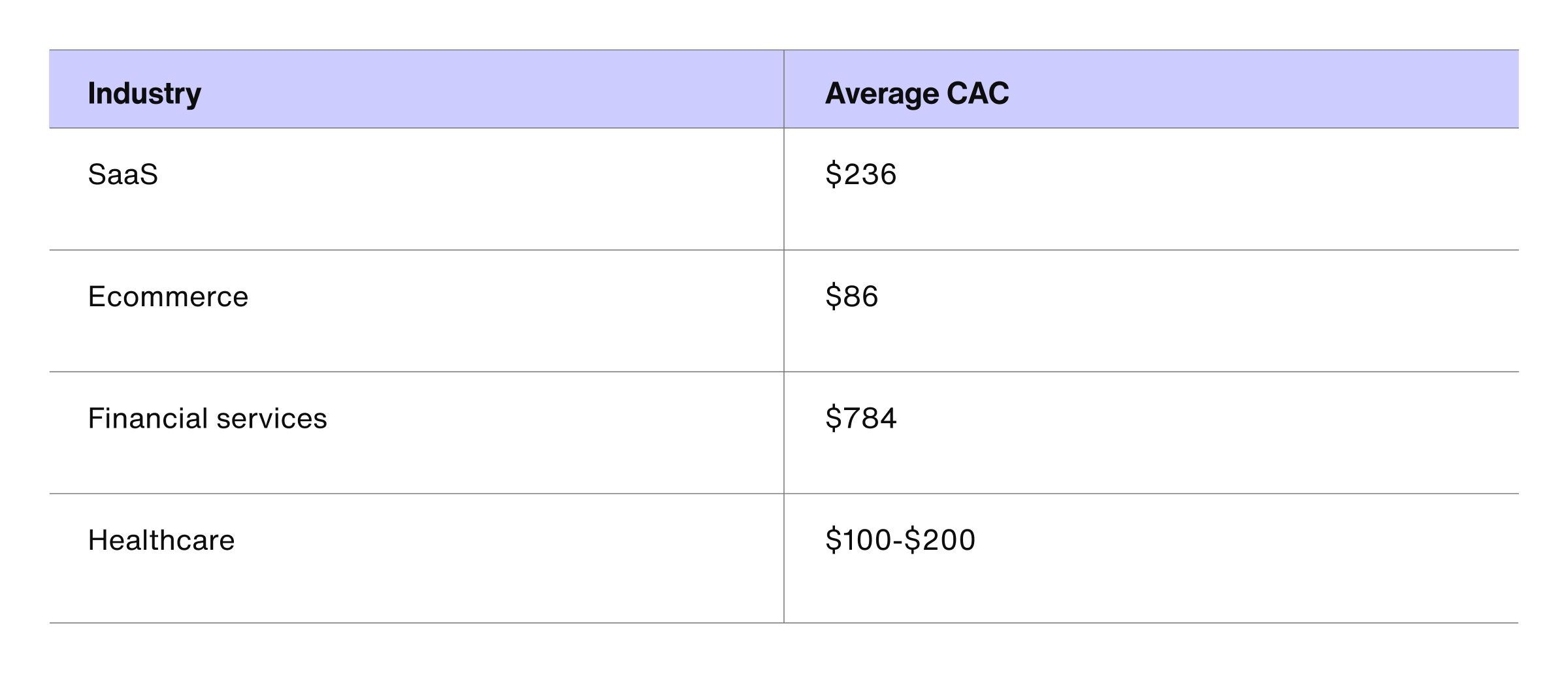
Understanding these benchmarks can help you assess your CAC in the context of your industry peers and identify areas for improvement.
How to analyze CAC
For a holistic assessment and analysis of CAC, businesses should consider the following extra tips and incorporate these into their strategy. By following these steps, businesses can gain a comprehensive understanding of their CAC, enabling them to optimize their acquisition strategies and maximize profitability.
Segment costs by channel: Break down the CAC by different acquisition channels (e.g., social media, email marketing, SEO, content marketing) to determine the most cost-effective channels.
Use attribution models: Implement attribution models to understand the contribution of various touchpoints in the customer journey, providing a clearer picture of where to allocate resources.
Track costs over time: Monitor CAC regularly to identify trends and fluctuations. This helps recognize seasonal impacts or changes due to new strategies or market conditions.
Analyze customer segments: Assess CAC for different customer segments, or even for various marketing campaigns or website funnels, to identify which segments provide the highest return on investment and tailor acquisition strategies accordingly.
Implement A/B testing: Conduct A/B testing on various acquisition strategies to determine which approaches result in lower CAC and higher conversion rates.
Now, let’s discuss CAC in the context of different business departments.
What is CAC in marketing, sales, and customer success?
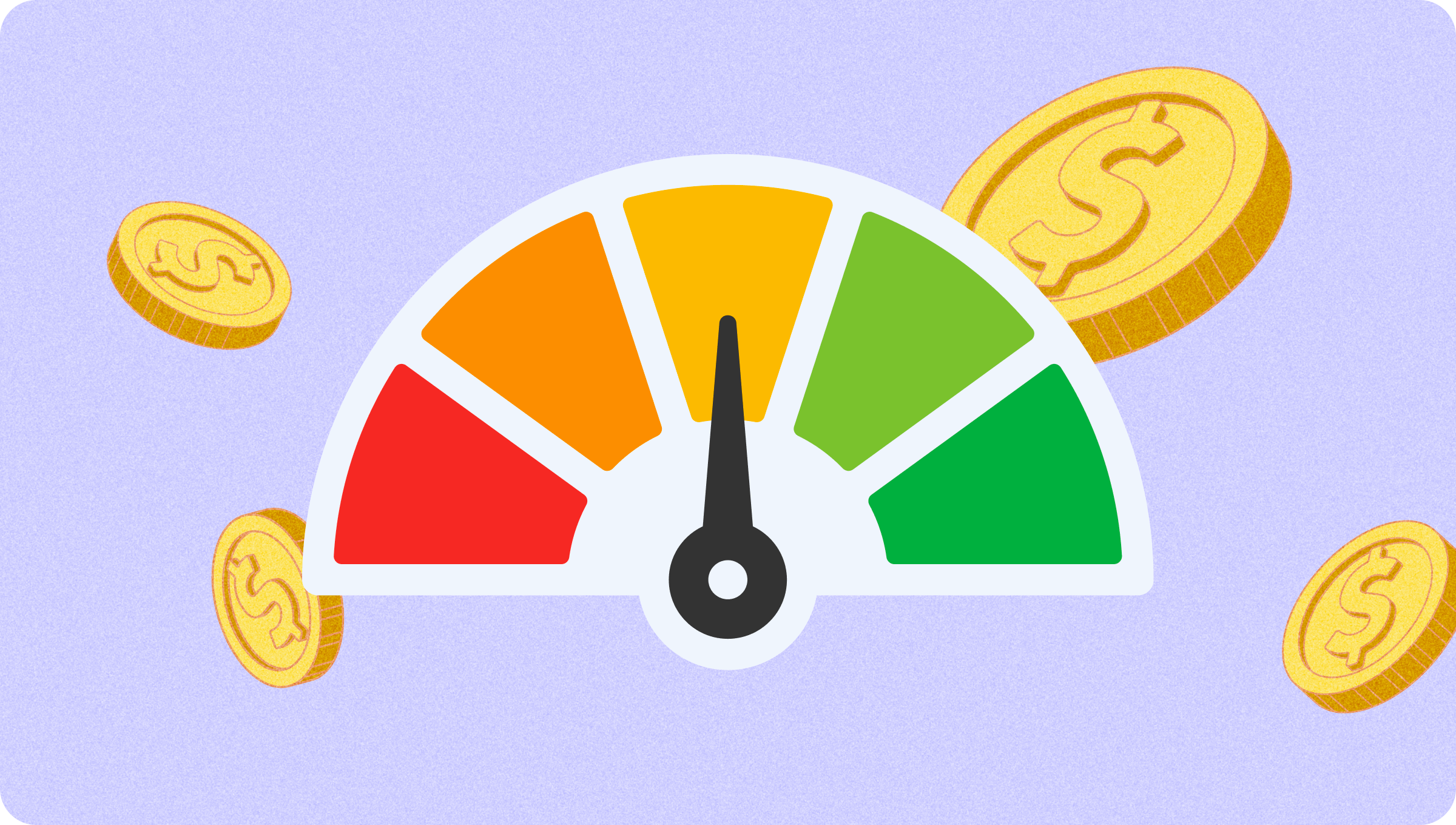
Customer acquisition cost (CAC) is critical in three main areas of your business: marketing, sales, and customer success. Here’s how CAC impacts each area.
Marketing
Marketing is all about ROI, so it’s crucial to carefully monitor CAC. The cost to acquire a customer is especially relevant when it comes to:
Budget allocation: Understanding CAC helps marketing teams allocate their budgets effectively so that funds are directed toward the most cost-effective channels and campaigns.
Campaign performance: By analyzing CAC, marketers can measure the performance of different campaigns and adjust strategies to focus on high-ROI activities.
Customer insights: CAC data provides insights into customer behavior and preferences, helping marketers tailor their messaging and targeting to attract high-value customers.
Sales
Sales is a numbers game; tracking key sales metrics and how they relate to or influence CAC is critical. These areas include:
Sales strategy: Sales teams use CAC to develop strategies that minimize costs and maximize efficiency. For example, they might focus on high-conversion segments to optimize the sales process.
Sales forecasting: Accurate CAC calculations help with forecasting sales performance and setting realistic targets.
Resource management: CAC helps sales leaders effectively manage resources, including sales personnel and tools, driving productivity and efficiency.
Customer success
Though customer success may not be the first department that comes to mind when we talk about CAC, it intersects with and impacts acquisition efforts in two key areas:
Creating brand champions: By providing excellent customer support and building long-term relationships with customers, you’re more likely to turn them into brand champions who send you business through referrals, also known as word of mouth. This source of new business can help lower your CAC and drive cost efficiencies, especially if you find ways to scale it through customer referral programs or creative use of customer loyalty programs.
Upselling and cross-selling: Another way to offset CAC is to focus on increasing customer lifetime value (LTV) by strategically pursuing opportunities for upselling and cross-selling to existing customers. This can boost revenue without incurring additional acquisition costs.
We’ve discussed CAC in detail, but it’s important to avoid looking at this metric in silos. To get a more nuanced picture of your business’s customer costs, it’s important to take into account another metric: Customer Lifetime Value (LTV).
The relationship between CAC and LTV: Why a high LTV also means a higher allowable CAC
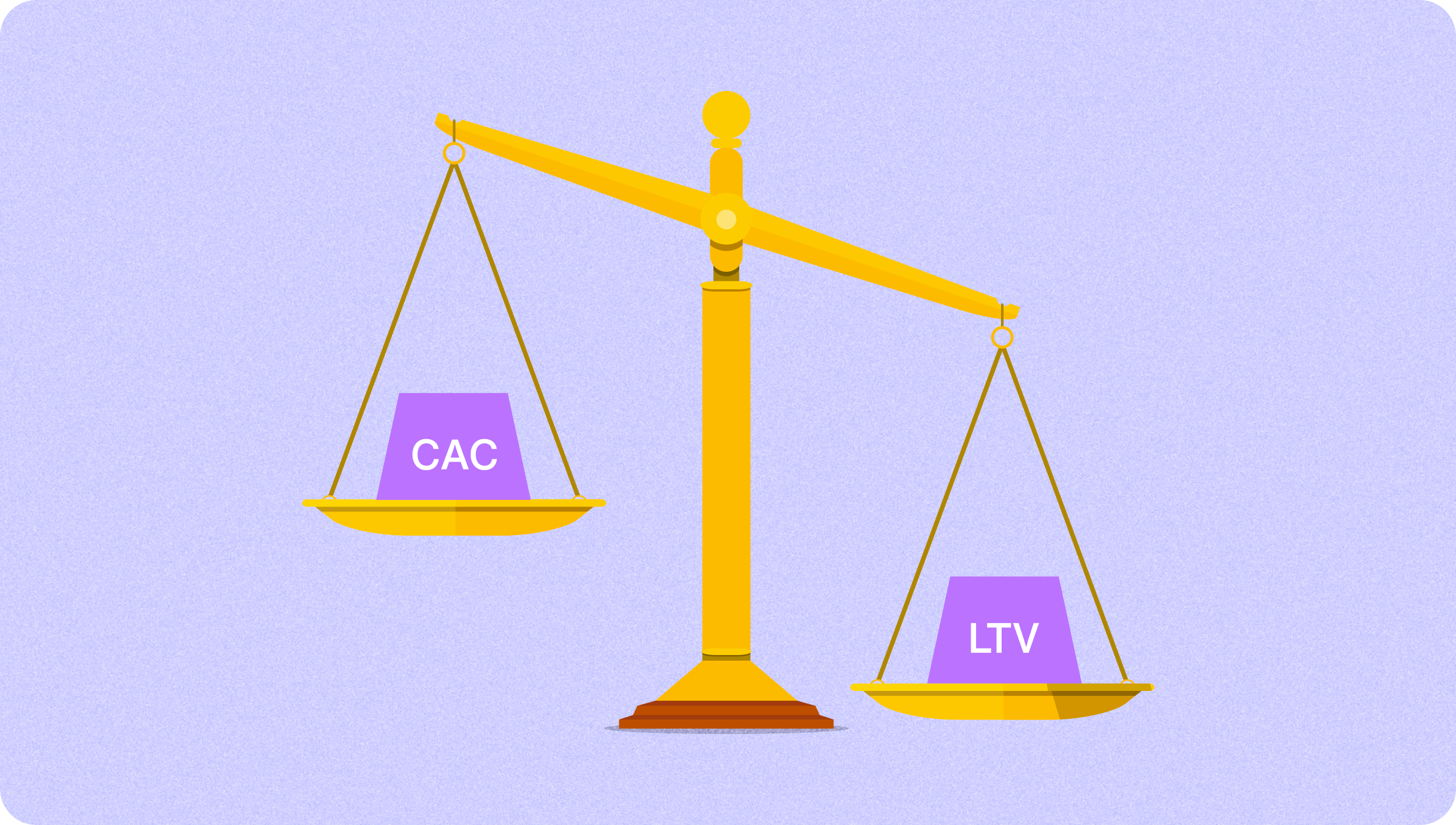
It’s hard to comprehend the true significance of CAC for your business without comparing it to Customer Lifetime Value (LTV). While CAC tells you the total spend to acquire a new customer, LTV measures the total revenue you can expect from a customer over their entire relationship with your business.
What is LTV?
Customer Lifetime Value (LTV) is a key business metric representing the total revenue a company can expect to generate from a single customer over the entire duration of their relationship. LTV helps businesses understand the long-term value of their customer base and make informed decisions about marketing, sales, and customer service investments. A higher LTV indicates that customers are generating more revenue over time, which can justify higher customer acquisition costs.
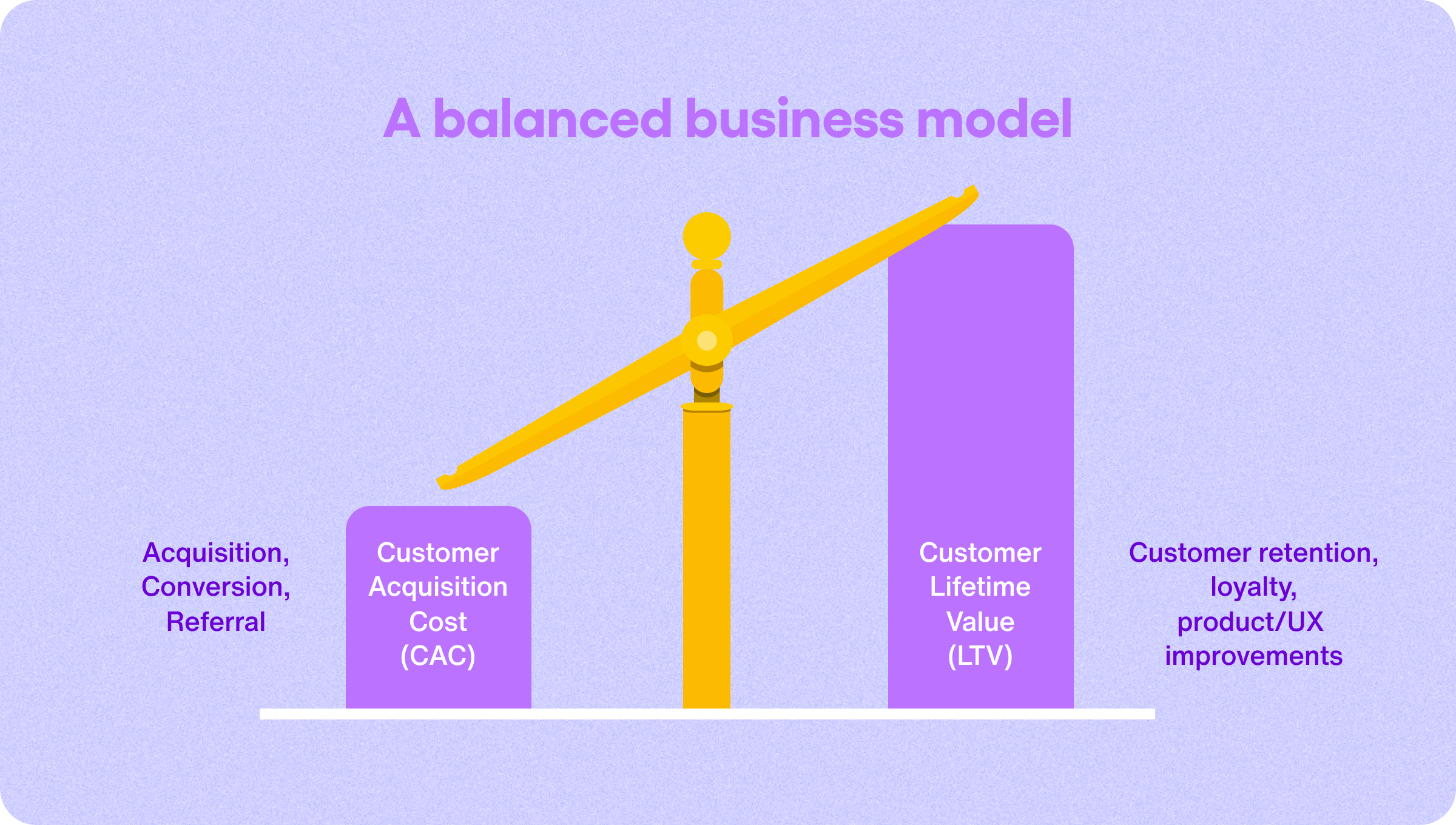
A healthy LTV to CAC ratio will show that the revenue you generate from a customer overwhelmingly outweighs the cost of acquiring them. While the ideal ratio varies by industry, a commonly cited LTV:CAC ratio is 3:1. This means that for every dollar you spend on acquiring a customer, you should expect to earn three dollars in return.
Let’s look at a simple example: If your CAC is $100 and your LTV is $300, then your LTV:CAC ratio is 3:1, which is a balanced and profitable customer acquisition strategy. But if you’re spending $100 on customer acquisition and only earning an average of $100 total from each customer, this tells you that your acquisition costs are too high — or your customer retention and upselling strategies need improvement.
Monitoring this ratio helps businesses make informed decisions about marketing spend, sales efforts, and customer success initiatives so they can work in concert to carve a sustainable path to growth.
LTV and customer acquisition cost example
Let’s look at an example to assess the impact that monitoring LTV and CAC together can have on business profitability.
Imagine a B2B software company, ABC Tech, that provides project management tools for medium to large enterprises. Over the past year, ABC Tech has been aggressively acquiring new customers through various marketing and sales channels. Despite a growing customer base, the company notices that its profitability isn't improving as expected.
To address this, ABC Tech decides to delve into CAC and LTV metrics. Here’s how understanding the LTV:CAC ratio can help improve their profitability:
The company calculates its CAC by summing up all marketing and sales expenses over the past year ($500,000) and dividing it by the number of new customers acquired (1,000). This results in a CAC of $500.
Then, they determine their average LTV by analyzing the revenue generated from customers over their lifetime with the company, which averages $1,200. With a CAC of $500 and an LTV of $1,200, ABC Tech has an LTV:CAC ratio of 2.4:1. This means that for every dollar spent on acquiring a customer, they earn $2.40 in return.
- They realize that while the ratio is positive, it’s not ideal. They aim for a 3:1 ratio for a more substantial return on investment. Therefore, ABC Tech makes these strategic adjustments:
Optimize marketing spend: ABC Tech analyzes its marketing channels and identifies that certain high-cost channels, like podcast and YouTube ads, aren’t yielding proportionate returns. By reallocating the budget to more cost-effective channels, they reduce overall marketing expenses.
Enhance customer retention: The company implements customer success initiatives to improve customer satisfaction and retention, thereby increasing the LTV. This includes offering personalized onboarding, regular check-ins, and value-added services.
Improve sales efficiency: ABC Tech invests in sales enablement tools to streamline the sales process. By automating manual tasks like email sequences, sales reps have more time to focus on converting leads, helping reduce the time to purchase.
The company recalculates its CAC and LTV six months later. Their CAC has decreased to $400 and their LTV has increased to $1,500, for a new CAC ratio of 1:3.75 — a notable increase in profitability.
Top 6 ways to reduce your CAC
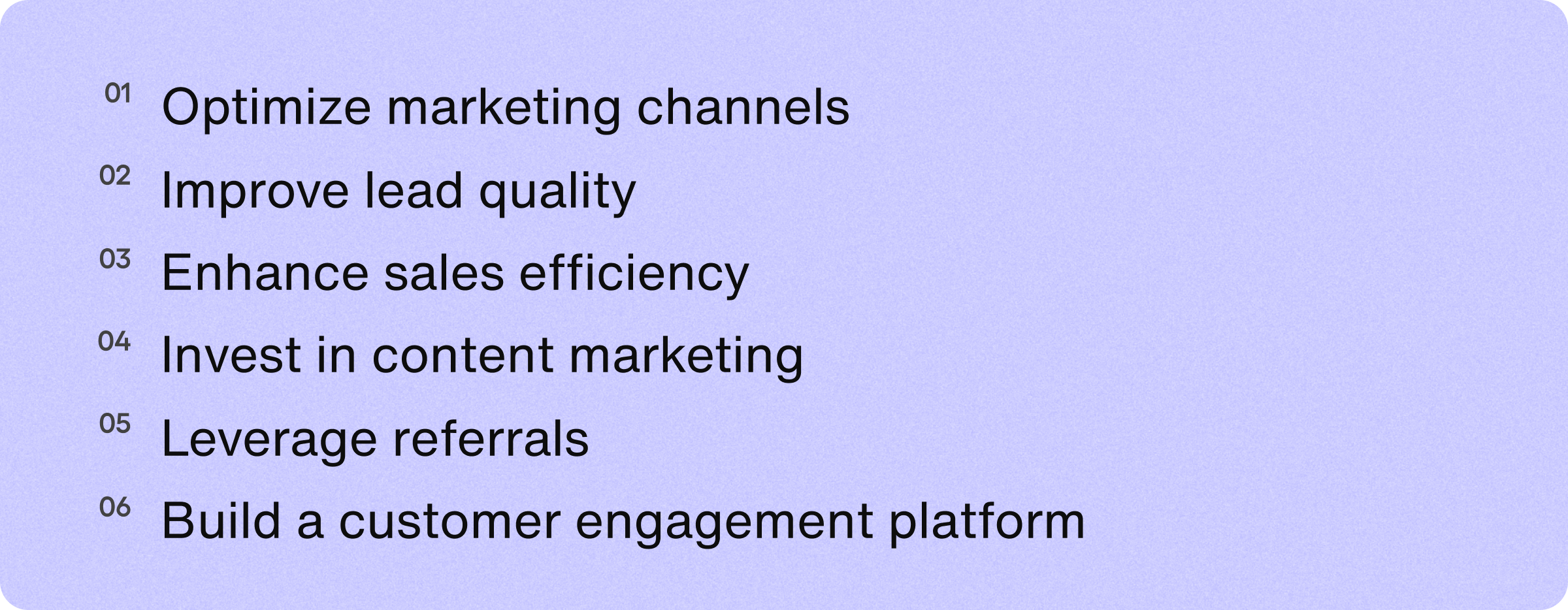
Reducing your CAC can significantly boost your profitability and allow for more efficient growth. Here are some effective strategies to help lower your customer acquisition costs:
Optimize marketing channels: Focus on the channels that bring in the highest ROI. Use data analytics to identify and invest more of your budget in the marketing channels that yield the best results. If organic social brings in far more qualified leads at a lower cost, shift more funds to that channel.
Improve lead quality: Enhance your targeting efforts to attract high-quality leads based on customer demographics and buyer personas. This will reduce the time and resources spent converting less promising leads and increase your overall conversion rate.
Enhance sales efficiency: Streamline your sales process to reduce the time and costs associated with closing deals. Implementing a CRM system can help your team manage leads more effectively and automate repetitive tasks so your sales reps can focus on moving sales forward.
Invest in content marketing: High-quality, informative content can attract and engage potential customers, allowing businesses to reduce their reliance on expensive paid advertising. This includes blogs, ebooks, case studies, whitepapers, and video content.
Leverage referrals: As discussed, it pays to encourage satisfied customers to refer new clients. Referral programs can be a cost-effective way to acquire new customers, as people are more likely to trust recommendations from friends and family.
Build a customer engagement platform: Platforms like Sendbird can enhance customer communication and engagement through in-app chat, calls, business messaging, and AI-powered chatbots, leading to higher satisfaction and retention rates. Engaged customers are more likely to stay with your business longer, increasing their LTV and offsetting acquisition costs.
Increase customer engagement and reduce your CAC today
Understanding and managing your CAC is vital for ensuring that your path to acquiring customers is the most profitable and efficient. Monitoring this key metric gives you critical insights into continually optimizing your marketing, sales, and customer success strategies. When you add LTV into the equation, you’ll have a clear picture of your business's overall health and profitability.
An important factor in keeping your LTV:CAC ratio balanced is keeping your current customers engaged and happy. By using a customer-first communications API platform like Sendbird, you can build a meaningful community for your customers. This can improve satisfaction, increase loyalty, and ultimately boost LTV. Investing in these strategies will help your business grow sustainably and profitably.
Ready to enhance customer engagement and achieve a better LTV:CAC ratio? Take the first step by acquiring the necessary tech. Sign up for free and see how Sendbird can meet your needs, or contact us to learn more.
Customer acquisition cost FAQs
Have questions about CAC? We’ve got all the answers for you.









